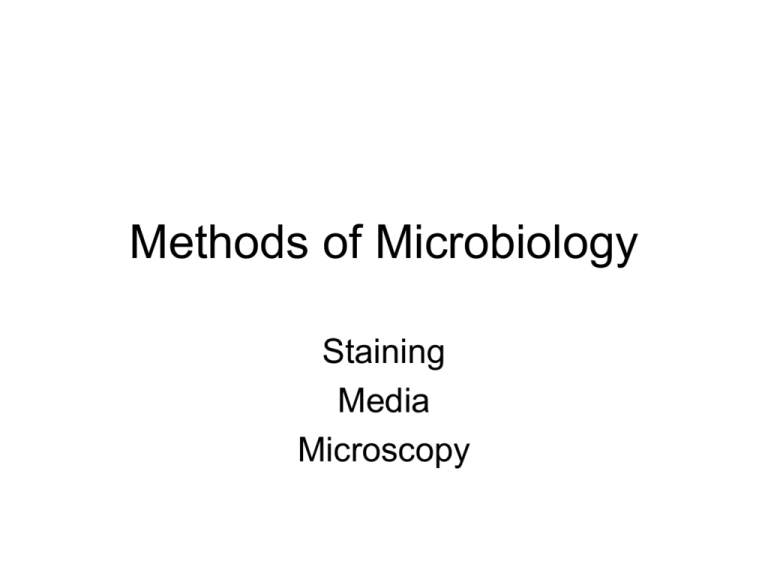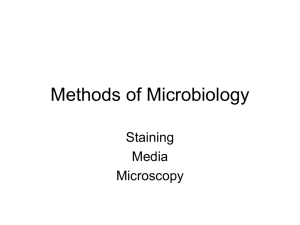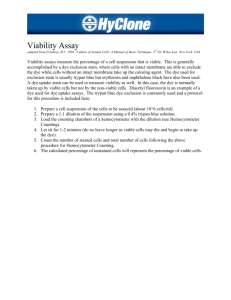Methods of Microbiology
advertisement

Methods of Microbiology Staining Media Microscopy Staining • Increase contrast of microorganisms • Classified into types of stains – Simple stain: – Differential stain: – Structural or special stains Dyes • Organic salts with positive and negative charges • One ion is colored –chromophore • Basic dye: positive ion is colored – MeBlue+ Cl- • Acidic dye: negative ion is chromphore Basic Dye • Works best in neutral or alkaline pH • Cell wall has slight negative charge at pH 7 • Basic dye (positive) attracted to cell wall ( negative) • Crystal violet, methylene blue, safranin Acidic Dye • Chromophore repelled by negative cell wall • Background is stained, bacteria are colorless • Negative stain-look at size, shape • Eosin, India ink Simple Stains • One dye, one step • Direct stain using basic dye • Negative stain using acidic dye Differential Stains • More than one dye • Gram stain, acid fast • Primary dye • Decolorizing step • Counter stain Special/ Structural Stains • Identify structures within or on cells • Different parts of cell are stained different colors Media • Culture media • Inoculum • Culture • Pure culture • Million cells to be visible Living vs Nonliving • Viruses, few bacteria • Living host-eggs, tissue cells • Mycobacterium leprae –armadillos • Most microbes grow on nonliving media Synthetic or Chemically Defined • Exact chemical composition known • Chemoheterotrophs – Glucose-carbon source & energy source – Supplies chemical requirements Complex Media • • • • • Used for most chemoheterotrophs Bacteria and fungi Cannot write formula for each ingredient C,N,energy, S requirements Vitamins, other growth factors Complex Media • Nutrient broth –liquid form • Nutrient agar –solid form – Plate – Deep – Slant Anaerobic Methods • Reducing media • Anaerobic jar • Use both in lab Candle Jar • Reduce oxygen levels • Provides more CO2 • Microaerophilics Selective and Differential Media • Selective • Differential Filtration • Passage of liquid through screen device • Pores small enough to retain microbes • Sterilize heat sensitive materials • Negative • Positive • HEPA hoods & TB rooms Autoclave • Uses temperature above boiling water • Steam under pressure • Preferred method unless material is damaged • Higher the pressure, higher the temperature • Need direct contact with steam • 15 psi at 121 C for 15 mins Autoclave • Prions- protein only • Flash sterilization-at 134 C for 3min • Packaging • Use of indicators Compound Microscope • Assigned scope • Know parts & functions • Proper use & care of scope Microscope • Use of light ( visible or UV) or electrons • Lenses to magnify • Total magnification of compound scope Lenses • Parfocal • Working distance Resolution • Ability to distinguish 2 objects as separate and distinct • Dictated by physical properties of light • Limit is 0.2um for our light scope Light Scope • Simple vs compound • Source of illumination • Visible light has average wavelength of 550nm or 0.55 um – Enters condenser lenses – Focused into a cone Light Path • Passes through opening in stage to slide • Light enters objective lens – Image magnified by ocular lens Contrast • Improves image detail • Difference in light intensity • Bacteria are colorless • Need to increase artificially by staining • Contrast is property of specimen Resolution • Distinguish detail within image • Property of lens system, measured as resolving power • Closest that 2 points can be together and still seen as separate • RP = wavelength of light 2 X NA Resolving Power • Function of numerical aperture: NA • Function of wavelength of light • Refractive index of material between objective lens & specimen Oil Immersion Lens • Light bends (refracts) as it passes from glass into air • Use oil between slide and 100x lens • Increases resolution Oil Immersion Lens • Lens captures more light • Shortest working distance • Summary: increased resolution Fluorescent Microscope • Used to view antigen antibody reactions • Specimen tagged with fluorescent dye • Ocular lens fitted with filter that permits longer wavelengths & blocks shorter ones • UV light(230-350nm) Electron Microscopy • Uses electrons as source of illumination • Wavelength of electrons is dependent upon voltage of electron beam







